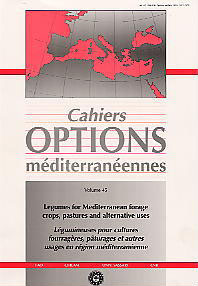| Article précédent | p. 161-165 | Article suivant |
Ten new annual legumes tested for unirrigated lands of the Mediterranean-climate region of Chile
At the Cauquenes Experimental Center INIA, Chile (35 degrees 58`S 72 degrees 17`W), phenology, persistence, forage and seed production were evaluated in 10 annual legumes of potential economic and rehabilitation ecology value for the Mediterranean sub-humid zone of Chile. These included 7 cultivars (cvs.) of yellow and pink serradellas (Ornithopus compressus and O. sativus, respectively), 2 cvs. of biserrula (Biserrula pelecinus) and one cv. of balansa clover (Trifolium michelianum). The study period extended over three successive, climatically contrasted years, with annual rainfall ranging from 900 mm vs. 259 mm per year. The results will be directly incorporated in an existing selection and improvement program seeking the broadest possible spectrum of germoplasm in terms of timing of growth, winter vigour, seed size and dormancy characteristics of the various candidate species and cvs.
- [ Télécharger ]
- [ Exporter la citation ]
Vous pouvez télécharger la citation au format :
- [ Imprimer ]
- [OMC45]




